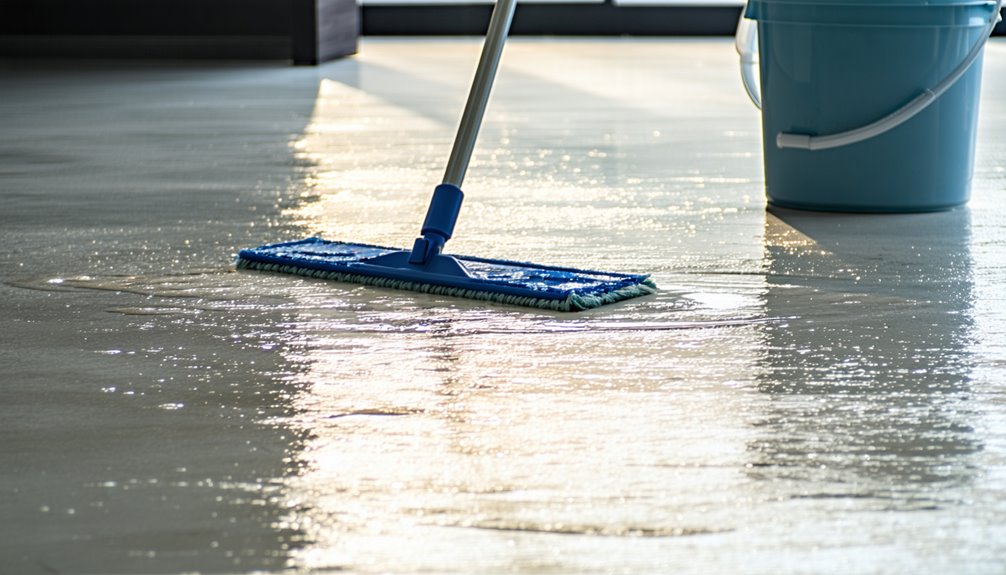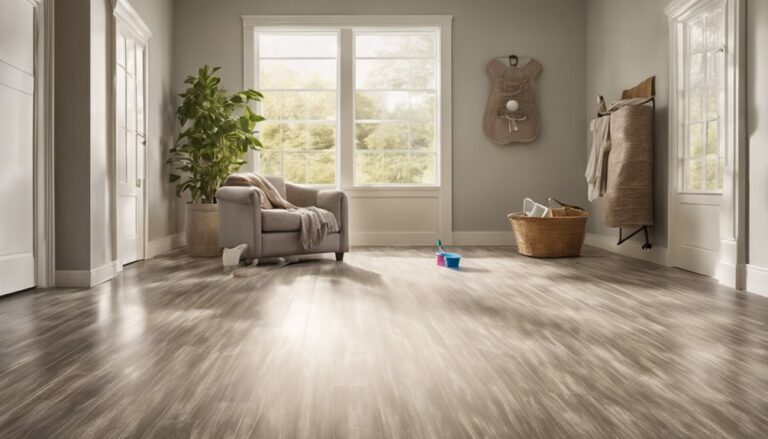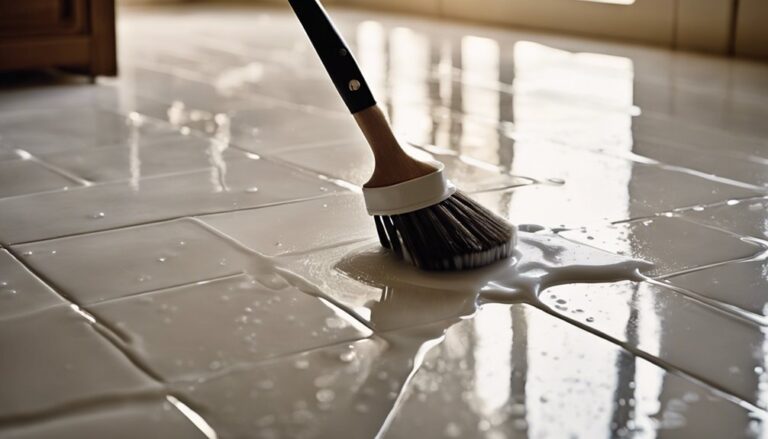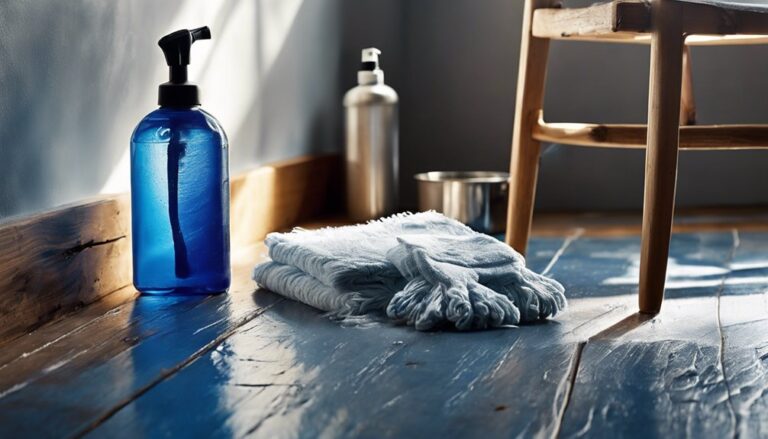Um einen Zementboden zu reinigen, legen Sie zunächst Ihre Reinigungsmittel bereit: einen robusten Besen, einen Mopp, einen pH-neutralen Reiniger und eine Scheuerbürste für hartnäckige Flecken. Fegen Sie den Boden, um zunächst losen Schmutz zu entfernen. Behandeln Sie Flecken je nach Art mit geeigneten Reinigungsmitteln vor. Mischen Sie anschließend Ihre Reinigungslösung gemäß den Herstellerangaben. Wischen Sie den Boden Gründlich reinigen und anschließend mit klarem, warmem Wasser abspülen, um Rückstände zu entfernen. Trocknen Sie die Oberfläche mit saugfähigen Tüchern und erhöhen Sie den Luftstrom mit Ventilatoren, um den Trocknungsprozess zu beschleunigen. Halten Sie Ihren Boden durch regelmäßige Pflege sauber. Hier finden Sie weitere Tipps für eine effektive Bodenpflege.
Besorgen Sie sich Ihre Reinigungsmittel
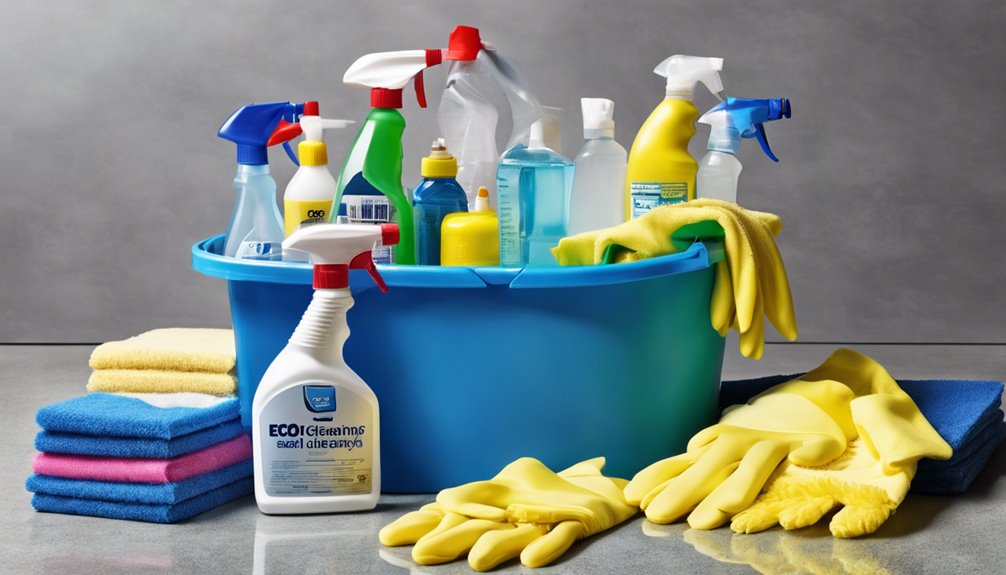
Bevor Sie mit der Reinigung Ihres Zementbodens beginnen, ist es wichtig, die richtigen Reinigungsmittel zu besorgen. Wählen Sie zunächst effektive Methoden, die auf Ihre Bedürfnisse zugeschnitten sind. Sie benötigen einen robusten Besen oder Staubsauger, um Staub und Schmutz zu entfernen und eine saubere Oberfläche zu gewährleisten. Wählen Sie anschließend geeignete Reinigungsutensilien wie einen Mopp mit robustem Moppkopf und einen Eimer zum Anrühren Ihrer Reinigungslösung. Ein pH-neutraler Reiniger ist ideal, da er den Zement nicht beschädigt. Vergessen Sie nicht eine Scheuerbürste für hartnäckige Flecken, und ein Abzieher hilft, überschüssiges Wasser zu entfernen. Nehmen Sie zum Schluss Lappen oder Handtücher zum Trocknen mit. Mit den richtigen Utensilien sind Sie bereit, Ihren Zementboden effizient und effektiv zu reinigen.
Lose Ablagerungen entfernen
Entfernen Sie zunächst alle losen Rückstände von Ihrem Zementboden, um eine gründliche Reinigung zu gewährleisten. Dieser erste Schritt ist unerlässlich für eine makellose Oberfläche. Sie benötigen die richtigen Reinigungswerkzeuge, um verschiedene Schmutzarten effektiv zu beseitigen:
- Besen zum Kehren von Staub und Schmutz
- Kehrschaufel zum Auffangen größerer Partikel
- Werkstattsauger für hartnäckigen Schmutz und kleine Partikel
Fegen Sie zunächst den gesamten Bereich und achten Sie darauf, auch Ecken und unter Möbeln zu erreichen. Bei stärkerem Schmutz erledigt ein Industriestaubsauger schnell die restlichen Reste. Indem Sie zuerst losen Schmutz entfernen, schaffen Sie die Grundlage für eine gründlichere Reinigung und stellen sicher, dass Schmutz und Flecken in den nächsten Schritten gründlich behandelt werden können. Diese methodische Vorgehensweise trägt dazu bei, die Langlebigkeit und das Aussehen Ihres Zementbodens zu erhalten.
Flecken vorbehandeln
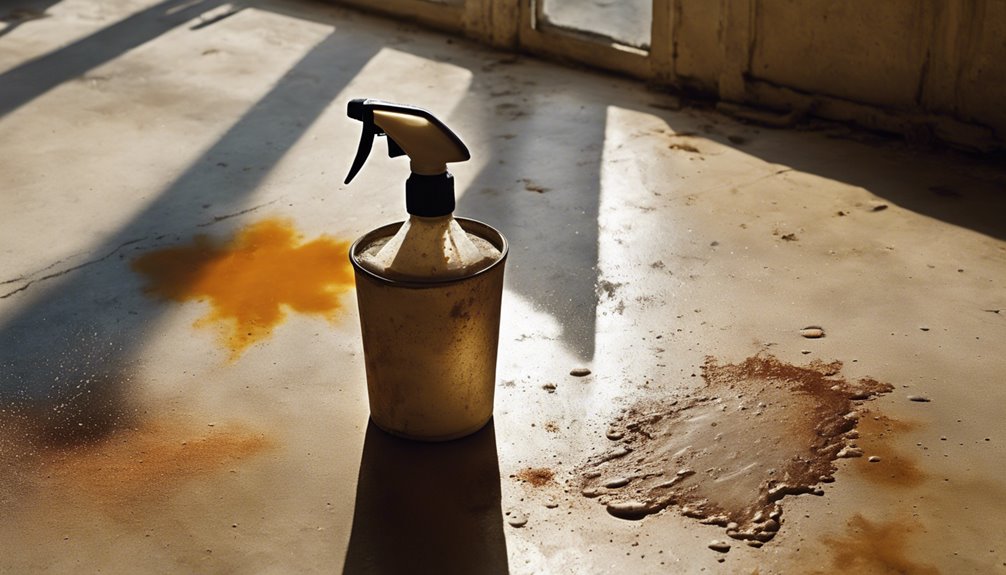
Bevor Sie mit dem Reinigen Ihres Zementbodens beginnen, ist es wichtig, alle Flecken vorzubehandeln, um eine gründliche Reinigung zu gewährleisten. Identifizieren Sie zunächst die vorhandenen Fleckenarten, da unterschiedliche Flecken spezifische Reinigungsmittel für eine effektive Entfernung erfordern. Sobald Sie die geeigneten Reiniger ermittelt haben, können Sie die richtigen Fleckenentfernungstechniken anwenden, um jeden Fleck effektiv zu beseitigen.
Fleckenarten identifizieren
Die Identifizierung der Fleckenarten auf Ihrem Zementboden ist für eine effektive Vorbehandlung unerlässlich, da unterschiedliche Flecken unterschiedliche Reinigungsmethoden erfordern. Untersuchen Sie Ihren Boden zunächst auf häufige Flecken, darunter:
- Ölflecken: Diese sind häufig in Garagen zu finden und können schwierig zu entfernen sein.
- Rostflecken: Diese werden typischerweise durch auf dem Boden liegende Metallgegenstände verursacht und erfordern besondere Aufmerksamkeit.
- Schimmelbildung: Dies kann in feuchten Bereichen auftreten und erfordert sofortiges Handeln.
Sie können auch auf Farbspritzer, Speisereste, verschüttete Chemikalien, Schmutzablagerungen und Wasserflecken stoßen. Jeder Fleckentyp hat seine eigenen Eigenschaften. Wenn Sie diese erkennen, können Sie die richtige Methode wählen, um Ihren Zementboden effektiv zu reinigen und seine Integrität zu erhalten.
Verwenden Sie geeignete Reinigungsmittel
Sobald Sie die Flecken auf Ihrem Zementboden identifiziert haben, ist es entscheidend, die richtigen Reiniger für eine effektive Vorbehandlung auszuwählen. Beginnen Sie mit der Bewertung der Fleckenarten. Ölbasierte Flecken benötigen Entfetter, während organische Flecken oft von enzymbasierten Reinigern profitieren. Bei Rostflecken sollten Sie nach säurehaltigen Reinigern suchen, diese aber vorsichtig verwenden, um den Zement nicht zu beschädigen. Für allgemeine Verschmutzungen ist ein pH-neutraler Reiniger ideal. Lesen Sie unbedingt die Etiketten, um sicherzustellen, dass die Reiniger für Ihre spezifischen Flecken geeignet sind. Die Vorbehandlung mit dem richtigen Reiniger verbessert die Gesamtwirksamkeit Ihres Reinigungsvorgangs und hilft, hartnäckige Flecken zu entfernen, bevor Sie mit intensiveren Reinigungsmethoden fortfahren. So erhält Ihr Boden die besten Chancen, sein bestes Aussehen zu bewahren.
Fleckenentfernertechniken anwenden
Um hartnäckige Flecken auf Ihrem Zementboden effektiv zu beseitigen, ist die Anwendung der richtigen Fleckenentfernungstechniken unerlässlich. Verschiedene Fleckenarten erfordern maßgeschneiderte Reinigungsmethoden für optimale Ergebnisse. So behandeln Sie hartnäckige Flecken vor:
- Flecken auf Ölbasis: Verwenden Sie einen Entfetter, um das Öl aufzulösen.
- Rostflecken: Tragen Sie einen Rostlöser auf und lassen Sie ihn wie angegeben einwirken.
- Flecken von Lebensmitteln und Getränken: Verwenden Sie zur natürlichen Reinigung eine Mischung aus Wasser und Essig.
Identifizieren Sie zunächst den Fleckentyp und tragen Sie dann den entsprechenden Reiniger direkt auf den Fleck auf. Lassen Sie ihn die empfohlene Einwirkzeit einwirken, bevor Sie vorsichtig schrubben. Spülen Sie gründlich ab und trocknen Sie die Stelle, um Rückstände zu vermeiden. Ihr Zementboden wird es Ihnen danken!
Bereiten Sie die Reinigungslösung vor
Die Vorbereitung der Reinigungslösung für Ihren Zementboden ist ein wichtiger Schritt und kann die Wirksamkeit Ihrer Reinigungsarbeiten maßgeblich beeinflussen. Wählen Sie zunächst geeignete Reinigungsmittel, z. B. ein mildes Reinigungsmittel oder einen speziellen Zementreiniger. Beachten Sie die Herstellerangaben zum Mischungsverhältnis. Für die allgemeine Reinigung mischen Sie in der Regel einen Teil Reinigungsmittel mit zehn Teilen Wasser. Bei hartnäckigeren Flecken können Sie das Mischungsverhältnis anpassen und die Konzentration erhöhen. Testen Sie Ihre Lösung immer zuerst an einer kleinen, unauffälligen Stelle, um sicherzustellen, dass sie die Oberfläche nicht beschädigt. Stellen Sie nach der Vorbereitung sicher, dass die Materialien anwendungsbereit sind, um einen reibungslosen und effizienten Reinigungsprozess zu gewährleisten. Diese Vorbereitung bildet die Grundlage für eine erfolgreiche Reinigung.
Den Boden fegen

Fegen Sie zunächst den Boden, um losen Schmutz, Staub und Ablagerungen zu entfernen, die den Reinigungsvorgang beeinträchtigen können. Effektive Kehrtechniken können einen erheblichen Unterschied machen. Ziehen Sie folgende Optionen in Betracht:
- Besen: Ideal für große Flächen, deckt schnell mehr Boden ab.
- Aufrechter Besen: Am besten für kleinere Räume geeignet, ermöglicht präzise Kontrolle.
- Winkelbesen: Ideal für Ecken und enge Stellen, stellt sicher, dass keine Rückstände zurückbleiben.
Wählen Sie einen Besentyp, der Ihren Bedürfnissen entspricht, und verwenden Sie lange, gleichmäßige Wischbewegungen. Beginnen Sie in einer Ecke und arbeiten Sie sich nach außen vor, damit Sie keine Stelle auslassen. Achten Sie auf Bereiche, in denen sich häufig Schmutz ansammelt, um eine saubere Grundlage für den nächsten Wischvorgang zu schaffen.
Wischen Sie die Zementoberfläche
Nachdem Sie den Boden gefegt und losen Schmutz entfernt haben, ist das Wischen der Zementoberfläche der nächste Schritt für eine gründliche Reinigung. Wählen Sie zunächst den richtigen Mopptyp, z. B. Mikrofaser, Schwamm oder einen herkömmlichen Fransenmopp, je nach Ihrer bevorzugten Reinigungstechnik.
| Mopptyp | Am besten für | Reinigungstechnik |
|---|---|---|
| Mikrofaser-Mopp | Leichter Schmutz und Staub | Schnelle, effiziente Reinigung |
| Schwammmopp | Flecken und Verschüttetes | Gründliches Schrubben |
| Wischmopp | Große Flächen | Traditionelle, gründliche Reinigung |
Verwenden Sie zum Wischen eine geeignete, mit Wasser verdünnte Reinigungslösung. Arbeiten Sie abschnittsweise und üben Sie mäßigen Druck aus, um hartnäckigen Schmutz zu entfernen. Achten Sie dabei auf eine gleichmäßige Abdeckung der Zementoberfläche für optimale Ergebnisse.
Gründlich ausspülen

Nachdem Sie den Zementboden gewischt und die Reinigungslösung entfernt haben, ist es wichtig, die Oberfläche gründlich abzuspülen, um Rückstände zu vermeiden. Effektive Spültechniken tragen maßgeblich zum Aussehen und zur Langlebigkeit Ihres Bodens bei.
- Verwenden Sie zum Spülen sauberes, warmes Wasser.
- Verwenden Sie einen Bodenabzieher, um überschüssiges Wasser zu entfernen.
- Wiederholen Sie das Spülen nach Bedarf, um sicherzustellen, dass keine Seifenreste vorhanden sind.
Die Häufigkeit des Spülens hängt von der Größe der Fläche und dem ursprünglichen Verschmutzungsgrad ab. Normalerweise reicht ein gründliches Spülen nach dem Wischen aus. Fühlt sich der Boden jedoch immer noch rutschig an oder weist er einen Film auf, zögern Sie nicht, erneut zu spülen. So bleibt Ihr Zementboden makellos und frei von unerwünschten Rückständen, sodass Sie Ihren Raum in vollen Zügen genießen können.
Trocknen Sie den Boden
Nachdem Sie Ihren Zementboden abgespült haben, ist es wichtig, ihn gründlich zu trocknen, um Feuchtigkeitsschäden zu vermeiden. Verwenden Sie zunächst saugfähige Tücher, um das restliche Wasser aufzusaugen, und stellen Sie anschließend einen Ventilator zur Verbesserung der Luftzirkulation ein. Prüfen Sie abschließend, ob noch Feuchtigkeit vorhanden ist, bevor Sie den Trocknungsvorgang abschließen.
Verwenden Sie saugfähige Handtücher
Um Ihren Zementboden effektiv zu trocknen, verwenden Sie zunächst saugfähige Tücher, die die Restfeuchtigkeit schnell aufnehmen. Die Wahl des richtigen Tuchtyps ist entscheidend für optimale Ergebnisse. Hier sind einige saugfähige Materialien, die Sie berücksichtigen sollten:
- Mikrofasertücher: Hohe Saugkraft und schonend zu Oberflächen.
- Baumwollhandtücher: Vielseitig und effizient für größere Flächen.
- Chamois-Handtücher: Hervorragend geeignet zum Aufsaugen von verschütteten Flüssigkeiten und zum schnellen Trocknen.
Wählen Sie einige dieser Tücher aus und drücken Sie sie vorsichtig auf die feuchten Stellen Ihres Bodens. Vermeiden Sie Reiben, da dies die Oberfläche beschädigen könnte. Lassen Sie die Tücher stattdessen kurz die Feuchtigkeit aufnehmen, wringen Sie sie aus und wiederholen Sie den Vorgang, bis der Boden trocken ist. Dieser Schritt garantiert eine saubere, sichere Oberfläche.
Beschäftigen Sie einen Ventilator
Während saugfähige Tücher helfen, Feuchtigkeit von Ihrem Zementboden zu entfernen, kann ein Ventilator den Trocknungsprozess erheblich beschleunigen. Bestimmen Sie zunächst den optimalen Standort des Ventilators. Idealerweise platzieren Sie ihn in der Nähe eines Fensters oder einer Tür, um die Belüftung zu optimieren. Sobald Sie sich für einen geeigneten Platz entschieden haben, richten Sie den Ventilator so aus, dass ein effektiver Luftstrom über die feuchten Bereiche strömt. Dadurch verdunstet die Feuchtigkeit schneller und Wasserflecken werden vermieden. Wenn Sie mehrere Ventilatoren haben, verwenden Sie diese zusammen, um größere Flächen abzudecken. Denken Sie daran, den Winkel regelmäßig anzupassen, um einen gleichmäßigen Luftstrom und damit eine gleichmäßige Trocknung zu gewährleisten. Mit dem strategischen Einsatz eines Ventilators erzielen Sie im Handumdrehen einen trockenen Zementboden.
Auf Feuchtigkeit prüfen
Bevor Sie mit der Reinigung oder Wartung fortfahren, prüfen Sie unbedingt Ihren Zementboden auf Feuchtigkeit. So stellen Sie sicher, dass sich keine überschüssige Feuchtigkeit ansammelt, die mit der Zeit zu Schäden führen kann. Nutzen Sie Methoden zur Feuchtigkeitserkennung, um die Luftfeuchtigkeit effektiv zu bestimmen.
- Auf sichtbare Feuchtigkeit oder Wasserflecken prüfen.
- Verwenden Sie für präzise Messwerte ein Feuchtigkeitsmessgerät.
- Überwachen Sie die Bodentemperatur. Kondensation kann auf Feuchtigkeitsprobleme hinweisen.
Sobald Sie Feuchtigkeit festgestellt haben, ergreifen Sie die notwendigen Maßnahmen, um den Boden vollständig zu trocknen. Ob mit Ventilatoren, Luftentfeuchtern oder einfach durch Lüften – eine trockene Oberfläche ist entscheidend für eine erfolgreiche Reinigung und langfristige Pflege. Ihr Zementboden wird es Ihnen danken!
Versiegelung auftragen (optional)
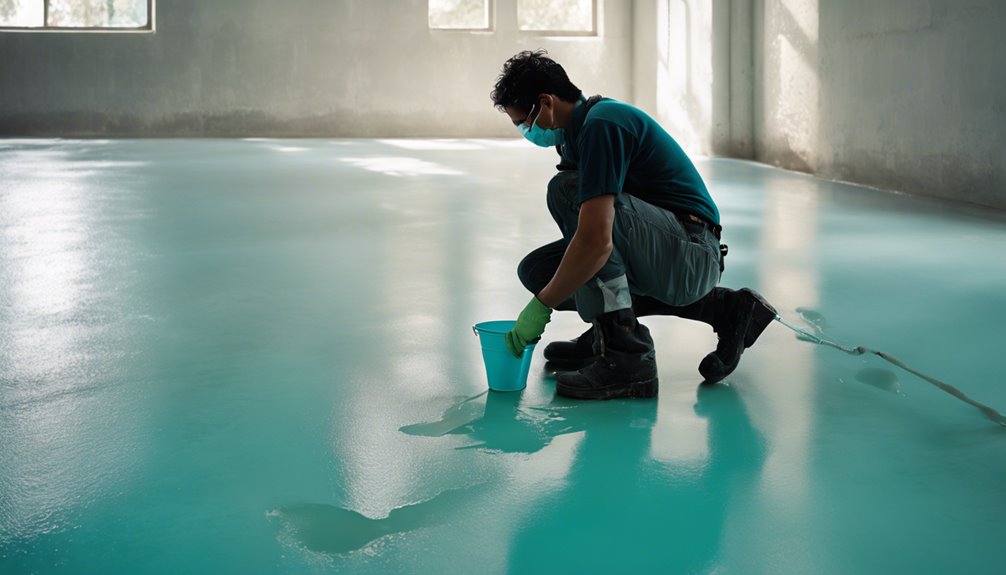
Das Auftragen einer Versiegelung auf Ihren Zementboden kann dessen Haltbarkeit und Aussehen deutlich verbessern. Mit effektiven Versiegelungstechniken schützen Sie Ihren Boden langfristig vor Flecken, Feuchtigkeit und Abnutzung. Wählen Sie zunächst eine hochwertige Versiegelung, die Ihren spezifischen Anforderungen entspricht – sei es eine Tiefenversiegelung oder eine oberflächliche Versiegelung. Stellen Sie vor dem Auftragen sicher, dass die Oberfläche sauber und trocken ist. Tragen Sie die Versiegelung gleichmäßig mit einer Rolle oder einem Sprühgerät auf und arbeiten Sie in kleinen Abschnitten. Lassen Sie die Versiegelung gemäß den Anweisungen des Herstellers aushärten, um die maximale Wirkung zu erzielen. Dieser optionale Schritt verlängert nicht nur die Lebensdauer Ihres Bodens, sondern erleichtert auch die spätere Reinigung. Die Investition in eine Versiegelung gibt Ihnen die Freiheit, Ihren Zementboden sorgenfreier zu genießen.
Regelmäßige Reinigung durchführen
Um sicherzustellen, dass Ihr Zementboden in einem optimalen Zustand bleibt, ist regelmäßige Reinigung unerlässlich. Eine regelmäßige Reinigungshäufigkeit beugt Schmutzablagerungen vor und verlängert die Lebensdauer des Bodens. Hier sind einige wichtige Pflegetipps:
- Fegen oder saugen Sie regelmäßig, um Schmutz zu entfernen.
- Wischen Sie alle paar Wochen mit einem pH-neutralen Reiniger.
- Beseitigen Sie verschüttete Flüssigkeiten sofort, um Flecken zu vermeiden.
Häufig gestellte Fragen
Kann ich einen Hochdruckreiniger auf Zementböden verwenden?
Ja, Sie können einen Hochdruckreiniger auf Zementböden verwenden, beachten Sie jedoch einige Tipps. Beginnen Sie mit einer niedrigeren Druckeinstellung, um die Betonoberfläche nicht zu beschädigen. Halten Sie die Düse mindestens 30 cm entfernt und führen Sie eine schwungvolle Bewegung aus. Es ist außerdem ratsam, Flecken vorzuweichen, um eine bessere Reinigung zu gewährleisten. Regelmäßige Pflege der Betonoberfläche verlängert die Lebensdauer Ihres Bodenbelags und erhält sein Aussehen.
Wie oft sollte ich meinen Zementboden reinigen?
Sie fragen sich vielleicht, wie oft Sie Ihren Zementboden reinigen sollten. Einerseits sorgt eine gründliche Reinigung dafür, dass er makellos aussieht; andererseits kann Vernachlässigung zu hartnäckigen Flecken führen. Idealerweise legen Sie einen regelmäßigen Reinigungsplan fest – monatlich für stark frequentierte Bereiche, seltener für andere. Beachten Sie Pflegetipps wie tägliches Kehren und die Verwendung milder Reinigungsmittel, um den Boden intakt zu halten. Vereinbaren Sie die regelmäßige Pflege mit Ihrem Lebensstil und genießen Sie einen sauberen Raum, ohne sich durch ständige Pflege belastet zu fühlen.
Welcher Mopptyp eignet sich am besten für Zementböden?
Bei der Wahl eines Mopps für Zementböden sollten Sie auf Materialien wie Mikrofaser oder Schwamm achten. Mikrofasermopps eignen sich hervorragend für Staub und Schmutz, während Schwammmopps verschüttete Flüssigkeiten effektiv aufnehmen. Verwenden Sie einen feuchten Mopp, um überschüssiges Wasser zu vermeiden, das die Oberfläche beschädigen kann. Wringen Sie den Mopp vor Gebrauch immer gut aus. Mit dem richtigen Mopp und der richtigen Technik pflegen Sie Ihre Böden mühelos und sorgen dafür, dass sie sauber und einladend bleiben.
Gibt es bestimmte Reinigungsprodukte, die man meiden sollte?
Möchten Sie beim Reinigen nicht die Schönheit Ihrer Oberflächen bewahren? Vermeiden Sie aggressive Chemikalien und säurehaltige Reiniger auf Ihrem Zementboden; diese können die Oberfläche beschädigen und bleibende Flecken hinterlassen. Entscheiden Sie sich stattdessen für sanfte, pH-neutrale Lösungen. Lesen Sie unbedingt die Etiketten sorgfältig und meiden Sie Produkte mit Ammoniak oder Bleichmittel, da diese mit der Zeit zu Verfärbungen und Abnutzung führen können. Ihr Boden verdient die beste Pflege!
Wie entferne ich altes Dichtungsmittel von Zement?
Um alte Versiegelung von Zement zu entfernen, wählen Sie zunächst den passenden Versiegelungsentferner für Ihren Zementtyp. Tragen Sie ihn gleichmäßig auf und lassen Sie ihn gemäß den Anweisungen des Herstellers einwirken. Verwenden Sie anschließend Streifentechniken, z. B. mit einem Bodenschrubber oder einem Schaber, um die Versiegelung effektiv zu entfernen. Arbeiten Sie in kleinen Abschnitten, um eine bessere Kontrolle zu gewährleisten. Spülen Sie den Bereich abschließend gründlich ab, um sicherzustellen, dass alle Rückstände entfernt sind, bevor Sie fortfahren.

